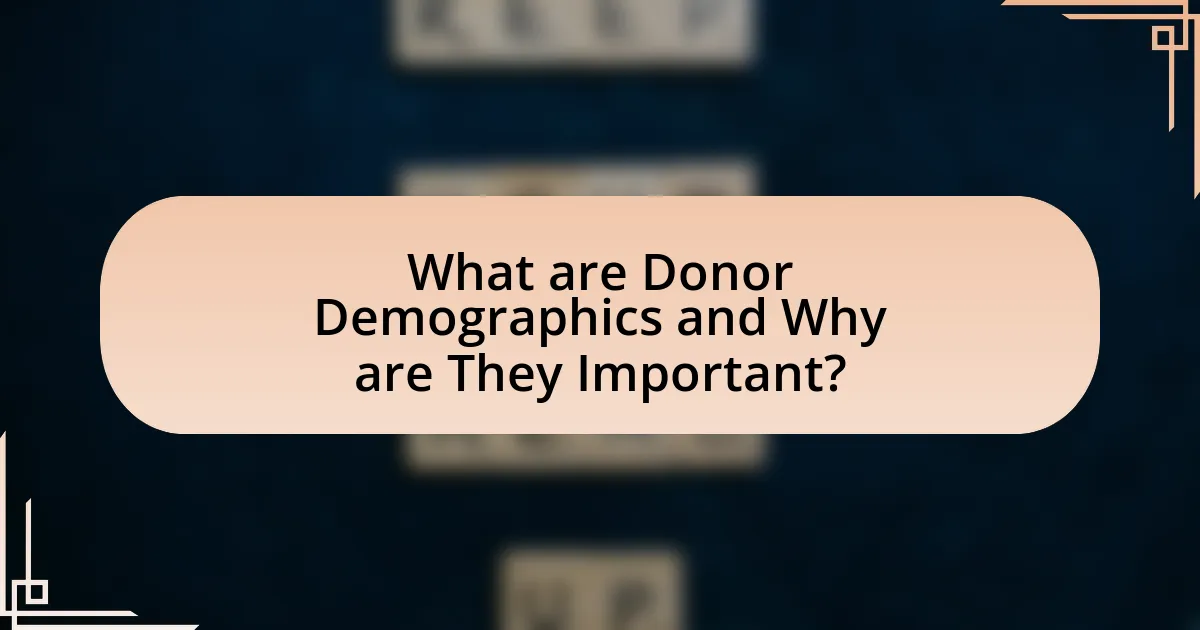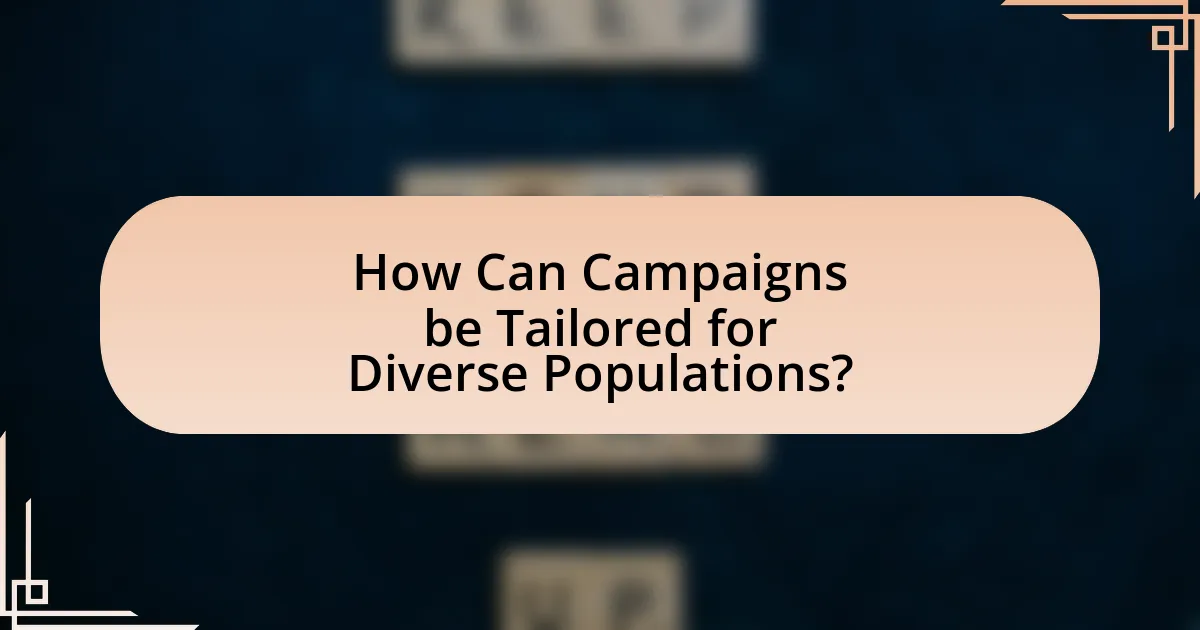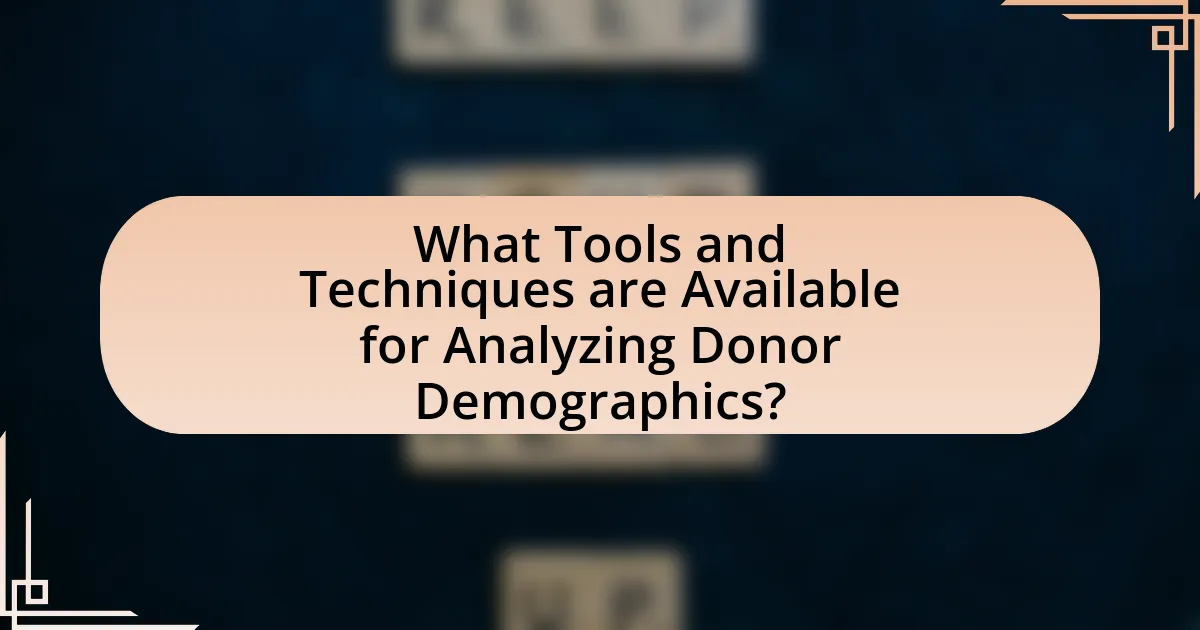The article focuses on analyzing donor demographics and the importance of tailoring fundraising campaigns for diverse populations. It highlights key demographic factors such as age, gender, income, education, and geographic location, which influence donor preferences and engagement strategies. The discussion includes the challenges organizations face in analyzing demographic data, the role of technology and data visualization in enhancing insights, and best practices for ensuring data accuracy and reliability. By understanding and segmenting donor demographics, organizations can create targeted campaigns that resonate with specific audiences, ultimately improving fundraising effectiveness and donor retention.
What are Donor Demographics and Why are They Important?

Donor demographics refer to the statistical characteristics of individuals who contribute to charitable organizations, including age, gender, income level, education, and geographic location. Understanding donor demographics is crucial because it enables organizations to tailor their fundraising campaigns to effectively engage specific segments of the population, thereby increasing the likelihood of donations. For instance, research indicates that targeted campaigns based on demographic insights can lead to a 20-30% increase in fundraising effectiveness, as they resonate more with the intended audience’s values and preferences.
How do donor demographics influence fundraising strategies?
Donor demographics significantly influence fundraising strategies by determining the preferences, motivations, and communication styles of potential donors. For instance, younger donors may prefer digital engagement and social media campaigns, while older donors might respond better to traditional methods like direct mail or in-person events. Research indicates that understanding these demographic factors can lead to more effective targeting; for example, a study by the Lilly Family School of Philanthropy found that tailored messaging based on age, income, and education levels can increase donor engagement and contributions. Thus, analyzing donor demographics allows organizations to customize their approaches, enhancing the likelihood of successful fundraising outcomes.
What key demographic factors should organizations consider?
Organizations should consider age, gender, income level, education, ethnicity, and geographic location as key demographic factors. Age influences preferences and engagement methods, while gender can affect communication styles and interests. Income level determines giving capacity, and education often correlates with awareness and values related to philanthropy. Ethnicity can shape cultural perspectives on giving, and geographic location impacts access to resources and community needs. Understanding these factors allows organizations to tailor their campaigns effectively, enhancing engagement and support from diverse populations.
How can understanding demographics improve donor engagement?
Understanding demographics can significantly improve donor engagement by enabling organizations to tailor their outreach strategies to specific audience segments. By analyzing demographic data such as age, income, education level, and geographic location, organizations can create targeted messaging that resonates with potential donors. For instance, a study by the Association of Fundraising Professionals found that personalized communication based on demographic insights can increase donor response rates by up to 50%. This targeted approach not only enhances the relevance of campaigns but also fosters a deeper connection between the organization and its supporters, ultimately leading to increased donations and long-term engagement.
What challenges do organizations face in analyzing donor demographics?
Organizations face several challenges in analyzing donor demographics, primarily due to data fragmentation and privacy concerns. Data fragmentation occurs when donor information is stored across multiple platforms, making it difficult to obtain a comprehensive view of donor demographics. Privacy concerns arise from regulations such as GDPR and CCPA, which restrict how organizations can collect and use personal data, complicating the analysis process. Additionally, organizations may struggle with the accuracy and completeness of the data, as incomplete records can lead to misleading conclusions about donor behavior and preferences. These challenges hinder effective targeting and personalization of fundraising campaigns, ultimately impacting donor engagement and retention.
How can data collection methods impact demographic analysis?
Data collection methods significantly impact demographic analysis by influencing the accuracy and representativeness of the data gathered. For instance, surveys conducted online may exclude populations with limited internet access, leading to biased results that do not accurately reflect the demographics of the entire population. Additionally, the wording of questions can affect responses; leading or ambiguous questions may skew data, resulting in misinterpretation of demographic trends. Research by the Pew Research Center indicates that different methodologies, such as face-to-face interviews versus telephone surveys, yield varying demographic insights, highlighting the importance of method selection in obtaining reliable data.
What are common pitfalls in interpreting donor demographic data?
Common pitfalls in interpreting donor demographic data include overgeneralization, misinterpretation of correlation versus causation, and neglecting the context of the data. Overgeneralization occurs when organizations assume that trends observed in a small sample apply to the entire donor base, leading to inaccurate conclusions. Misinterpretation of correlation versus causation can result in erroneous assumptions about the reasons behind donor behavior, such as assuming that age directly influences donation amounts without considering other factors like income or personal values. Additionally, neglecting the context of the data, such as economic conditions or cultural influences, can lead to misleading insights and ineffective campaign strategies. These pitfalls can significantly hinder the ability to tailor campaigns effectively for diverse populations.
How Can Campaigns be Tailored for Diverse Populations?

Campaigns can be tailored for diverse populations by utilizing demographic data to understand the unique needs, preferences, and cultural contexts of different groups. This approach involves segmenting the target audience based on factors such as age, ethnicity, socioeconomic status, and geographic location, allowing for customized messaging and outreach strategies. For instance, research shows that culturally relevant messaging can increase engagement; a study by the Pew Research Center found that 61% of Hispanic respondents prefer content that reflects their cultural identity. By incorporating inclusive language, visuals, and channels that resonate with specific communities, campaigns can foster a sense of belonging and increase participation rates among diverse populations.
What strategies can be employed to customize campaigns?
To customize campaigns effectively, organizations can employ strategies such as segmenting donor demographics, personalizing messaging, and utilizing data analytics. Segmenting donor demographics allows organizations to identify distinct groups based on characteristics like age, income, and interests, enabling targeted outreach. Personalizing messaging involves crafting communication that resonates with specific segments, enhancing engagement and response rates. Utilizing data analytics helps organizations track campaign performance and donor behavior, allowing for real-time adjustments and improved targeting. These strategies are supported by research indicating that personalized campaigns can increase donor retention by up to 50%, demonstrating their effectiveness in engaging diverse populations.
How can messaging be adapted for different demographic groups?
Messaging can be adapted for different demographic groups by tailoring language, tone, and content to resonate with specific cultural, social, and economic characteristics of each group. For instance, research shows that younger audiences respond better to informal language and digital platforms, while older demographics may prefer traditional communication methods and formal language. Additionally, using culturally relevant references and addressing specific values or concerns can enhance engagement; for example, messaging that emphasizes community impact may resonate more with certain ethnic groups. This approach is supported by studies indicating that targeted messaging increases response rates and donor engagement, demonstrating the effectiveness of demographic adaptation in communication strategies.
What role does cultural sensitivity play in campaign design?
Cultural sensitivity plays a crucial role in campaign design by ensuring that messaging and strategies resonate with diverse audiences. This approach helps organizations avoid cultural missteps that can alienate potential donors and fosters inclusivity, which is essential for effective communication. For instance, research indicates that campaigns that consider cultural nuances can increase engagement by up to 50%, as they align more closely with the values and beliefs of targeted demographics. By integrating cultural sensitivity into campaign design, organizations can enhance their outreach and build stronger connections with varied populations, ultimately leading to increased support and donations.
Why is segmentation crucial in tailoring campaigns?
Segmentation is crucial in tailoring campaigns because it allows organizations to customize their messaging and strategies to meet the specific needs and preferences of different donor groups. By analyzing donor demographics, organizations can identify distinct segments based on factors such as age, income, interests, and past giving behavior. This targeted approach increases engagement and improves the effectiveness of campaigns, as evidenced by research indicating that personalized communication can lead to a 20% increase in response rates compared to generic messaging.
What are the benefits of segmenting donor populations?
Segmenting donor populations enhances fundraising effectiveness by allowing organizations to tailor their campaigns to specific groups. This targeted approach increases engagement, as messages resonate more with the unique interests and motivations of each segment. For instance, research shows that personalized communication can lead to a 20% increase in response rates compared to generic outreach. Additionally, segmenting donors helps organizations allocate resources more efficiently, focusing efforts on high-potential segments, which can result in a higher return on investment. By understanding the demographics, preferences, and giving behaviors of different donor groups, organizations can create more compelling and relevant campaigns, ultimately driving greater support and loyalty.
How can organizations effectively segment their donor base?
Organizations can effectively segment their donor base by utilizing demographic, behavioral, and psychographic data. By analyzing factors such as age, income, location, and giving history, organizations can create targeted campaigns that resonate with specific donor groups. For instance, a study by the Association of Fundraising Professionals found that tailored communication strategies can increase donor engagement by up to 50%. This data-driven approach allows organizations to optimize their fundraising efforts and enhance donor retention.
What Tools and Techniques are Available for Analyzing Donor Demographics?

Tools and techniques available for analyzing donor demographics include data analytics software, customer relationship management (CRM) systems, and demographic segmentation methods. Data analytics software, such as Tableau or Google Analytics, allows organizations to visualize and interpret donor data effectively. CRM systems, like Salesforce or Blackbaud, help track donor interactions and preferences, enabling targeted communication. Demographic segmentation methods categorize donors based on characteristics such as age, income, and location, facilitating tailored outreach strategies. These tools and techniques enhance understanding of donor behavior and preferences, ultimately improving fundraising efforts.
What data analysis tools can enhance demographic insights?
Data analysis tools that can enhance demographic insights include Tableau, R, and Python. Tableau allows for visual data representation, making it easier to identify trends and patterns in demographic data. R provides extensive statistical analysis capabilities, enabling users to perform complex data manipulations and visualizations tailored to demographic studies. Python, with libraries such as Pandas and Matplotlib, offers flexibility in data processing and visualization, allowing for customized analysis of demographic information. These tools are widely used in the field, as evidenced by their adoption in various demographic research projects and their ability to handle large datasets effectively.
How do CRM systems support donor demographic analysis?
CRM systems support donor demographic analysis by aggregating and organizing data related to donor characteristics, behaviors, and preferences. These systems enable organizations to segment donors based on various demographics such as age, location, income level, and giving history, allowing for targeted communication and personalized engagement strategies. For instance, a study by Blackbaud found that organizations utilizing CRM systems for donor analysis reported a 20% increase in donor retention rates due to more tailored outreach efforts. This data-driven approach enhances the ability to understand donor motivations and optimize fundraising campaigns effectively.
What role does data visualization play in understanding demographics?
Data visualization plays a crucial role in understanding demographics by transforming complex data sets into accessible visual formats that highlight patterns and trends. This visual representation allows stakeholders to quickly identify key demographic characteristics, such as age, gender, income, and geographic distribution, which are essential for tailoring campaigns effectively. For instance, studies show that organizations using data visualization tools can increase their understanding of target populations by up to 80%, enabling more informed decision-making and strategic planning.
How can organizations leverage technology for better demographic analysis?
Organizations can leverage technology for better demographic analysis by utilizing data analytics tools and software that aggregate and analyze demographic data efficiently. These tools enable organizations to collect vast amounts of data from various sources, such as social media, surveys, and transaction records, allowing for a comprehensive understanding of donor demographics. For instance, platforms like Tableau and Google Analytics provide visualizations and insights that help organizations identify trends and patterns within their donor base, facilitating targeted campaigns. Additionally, machine learning algorithms can predict donor behavior based on historical data, enhancing the ability to tailor outreach efforts. According to a report by the Pew Research Center, organizations that employ data-driven strategies see a 5-10% increase in campaign effectiveness, demonstrating the tangible benefits of leveraging technology for demographic analysis.
What emerging technologies are shaping donor demographic analysis?
Emerging technologies shaping donor demographic analysis include artificial intelligence, machine learning, and big data analytics. These technologies enable organizations to process vast amounts of data, identify patterns, and segment donor populations more effectively. For instance, AI algorithms can analyze donor behavior and preferences, leading to more personalized engagement strategies. Additionally, big data analytics allows for the integration of diverse data sources, enhancing the understanding of donor demographics and improving targeting efforts. This technological advancement is supported by studies showing that organizations leveraging these technologies see increased donor retention and engagement rates.
How can machine learning improve demographic targeting?
Machine learning can improve demographic targeting by analyzing vast datasets to identify patterns and preferences among different demographic groups. This technology enables organizations to segment their audience more accurately, allowing for personalized marketing strategies that resonate with specific populations. For instance, machine learning algorithms can process data from social media interactions, purchase histories, and online behavior to predict which demographic segments are most likely to engage with particular campaigns. Studies have shown that targeted marketing efforts can increase conversion rates by up to 50%, demonstrating the effectiveness of machine learning in enhancing demographic targeting.
What are best practices for analyzing donor demographics?
Best practices for analyzing donor demographics include segmenting donors by key characteristics such as age, income, location, and giving history. This segmentation allows organizations to tailor their fundraising strategies effectively. Utilizing data analytics tools can enhance the understanding of donor behavior and preferences, leading to more personalized communication. Regularly updating demographic data ensures accuracy and relevance, while conducting surveys can provide insights into donor motivations and interests. Research indicates that organizations that effectively analyze donor demographics can increase donor retention rates by up to 30%, demonstrating the importance of targeted approaches in fundraising efforts.
How can organizations ensure data accuracy and reliability?
Organizations can ensure data accuracy and reliability by implementing robust data governance frameworks. These frameworks include regular data validation processes, which involve cross-referencing data against trusted sources to identify discrepancies. For instance, a study by the Data Management Association found that organizations with established data governance practices experience a 30% reduction in data errors. Additionally, training staff on data entry best practices and utilizing automated data collection tools can further enhance accuracy. Regular audits and feedback loops also contribute to maintaining data integrity over time.
What steps should be taken to regularly update demographic data?
To regularly update demographic data, organizations should implement a systematic approach that includes periodic data collection, validation, and analysis. This process involves conducting surveys or utilizing existing databases to gather current demographic information, ensuring that the data reflects the latest population trends. Additionally, organizations should establish a schedule for reviewing and updating this data, such as annually or biannually, to maintain accuracy. Utilizing technology, such as data management systems, can facilitate the tracking and updating of demographic information efficiently. Regular training for staff on data collection methods and the importance of accurate demographic data can further enhance the reliability of the information gathered.
What practical tips can organizations implement for effective demographic analysis?
Organizations can implement several practical tips for effective demographic analysis, including utilizing data segmentation, employing surveys for direct feedback, and leveraging analytics tools. Data segmentation allows organizations to categorize donors based on specific characteristics such as age, location, and giving history, which enhances targeted outreach. Surveys provide valuable insights into donor preferences and motivations, enabling organizations to tailor their campaigns effectively. Additionally, analytics tools can help track engagement metrics and demographic trends, facilitating informed decision-making. These strategies collectively enhance the understanding of diverse populations, ultimately leading to more successful fundraising campaigns.